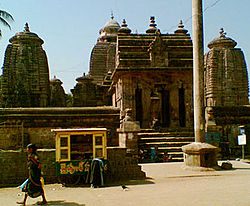Mukhalingam
Mukhalingam
Srimukhalingam | |
|---|---|
Village | |
 Srimukhalingam temple | |
 Dynamic map | |
| Coordinates:18°36′00″N83°58′00″E/ 18.6000°N 83.9667°E | |
| Country | |
| State | Andhra Pradesh |
| District | Srikakulam |
| Talukas | Jalumuru |
| Population | |
| • Total | 3,204 |
| Languages | |
| • Official | Telugu |
| Time zone | UTC+5:30(IST) |
| PIN | 532428 |
| Vehicle Registration | AP30 (Former) AP39 (from 30 January 2019)[1] |
Mukhalingam,also known asSrimukhalingamorMukhalinga,is a village panchayat inJalumurumandal ofSrikakulam districtin the Indian state ofAndhra Pradesh.Historically known as Kalinganagari, Mukhalingam served as the capital of Eastern Ganga Dynasty from 6th century AD to 12th century AD. Emperor Sri Ananthavarma Chodaganga Devara conquered Utkala in 1122 AD and shifted the capital from Kalinganagari to Caudwara kataka[2]
The village is located on the left bank ofVamsadharariver at a distance of 48 km fromSrikakulamtown( nearest rail head ) and 160 km fromVisakhapatnam( nearest airport).[3]
Mukhalingam is home to a group of three Śiva temples - Madhukeswara, Someswara, Bhimeswara - which have been variously dated by historians from late eighth century to early eleventh century CE.[4][5]Mukhalingam was the erstwhile capital of theEastern Gangadynasty. The main temple of Sri Mukhalingam was built by Eastern Ganga King Kamaranaba Deva II, great-grand father ofAnantavarman ChodagangaofKalinga.
Etymology[edit]
Various views by have been put forward for the origin of the name Mukhalingam. It states that "Mukhalingam" is a corruption of "Mohalingam", which is theOdia/Prakritform of "Madhu[ka]linga".[6]Another view states that thelingaat the Madhukeswara shrine is a faceted one and therefore the shrine and the town were termed asMukhalingawith "Mukha" meaning face inSanskrit/Telugu/Odia.[7]It as also been posited that "Mukhalingam" is derived from "Mudu-Kalingam" which is the Telugu translation of the Sanskrit word "Tri-kalinga".[8][7]Mukhalingam was the main city in the region ofKalinga,also known in the ancient period as Tri-Kalinga because it was divided into three regions.[7]
Geography[edit]
Mukhalingam is located at18°35′39″N83°57′49″E/ 18.5943°N 83.9635°E.[9]It has an average elevation of 28 metres (92 ft).
Transportation[edit]
Srimukhalingam is well connected by road ways. Andhra Pradesh State Highway 106 passes through Srimukhalingam village.[10]
APSRTCoperates several buses fromSrikakulambus stand toSrimukhalingamvillage. Many of autos, taxis and cabs are also available fromChallavanipetavillage to Srimukhalingam village. The village is also very near toParalakhemunditown, district Headquarter ofGajapati DistrictofOdishastate. Auto, taxi, bus, cabs facilities are there from the town.
Andhra Pradesh SH106 ConnectsJarjangi,Challavanipeta,Jalumuru,Budithi, Komanapalli and Pindruvada villages with Sri Mukhalingam village.
Demographics[edit]
According to the2011 Census of India,the demographic details of Mukhalingam are as follows:[11]
- Total Population: 3,022 in 837 Households
- Male Population: 1,504 and Female Population: 1,518
- Children under six years of age: 265 (Boys - 139 and Girls - 126)
- Literacy rate: 63.58%
Culture[edit]
The dating of the temples has been contested among historians. The temples have been variously dated from late eighth century to eleventh century CE.[4][5][12]The earliest among them was constructed in the late eighth or early ninth century and the latest one dates to early eleventh century.[13][14]Later in 17th century Maharaja ofParalakhemundi Estaterenovated this temple.[15][16]Every year famous Chakratirtha Snana (holy bath) is taken by pilgrims. Lakhs of pilgrims visit from Odisha and Andhra Pradesh on the auspicious day to take the holy bath and take blessings of Lord Shiva. Before 1936 it was under undividedGanjam District.
Gallery[edit]
-
A relief of Trimurti on a dome at Sri Mukhalingam temple complex
-
View of a dome at Sri Mukhalingam Temple complex
-
A relief carved out on walls for a drain at Sri Mukhalingam
-
A Temple in Sri Mukhalingam temple complex
References[edit]
- ^"New 'AP 39' code to register vehicles in Andhra Pradesh launched".The New Indian Express.Vijayawada. 31 January 2019. Archived fromthe originalon 3 February 2019.Retrieved9 June2019.
- ^Rajguru, Padmashri Dr. Satyanarayana(1972).History of Gangas.History of Ganga. Vol. Part 2. Superintendent of Museum, Orissa, Bhubaneswar. p. 39.
- ^"Srimukhalingam".Andhra Pradesh Tourism.Andhra Pradesh Tourism Authority. 12 March 2015.Retrieved20 April2023.
- ^abMurthy, K. Krishna (1987).Glimpses of Art, Architecture, and Buddhist Literature in Ancient India.Abhinav Publications. p. 71.ISBN978-81-7017-226-0.
- ^abDavidson, Ronald M. (2004).Indian Esoteric Buddhism: Social History of the Tantric Movement.Motilal Banarsidass Publ. p. 342.ISBN978-81-208-1991-7.
- ^Hultzsch, E. (ed.).Epigraphia Indica Vol 4.Calcutta. p. 188.Retrieved20 March2023.
- ^abcMurthy, K. Krishna (1987).Glimpses of Art, Architecture, and Buddhist Literature in Ancient India.Abhinav Publications. p. 65.ISBN978-81-7017-226-0.
- ^Sastry, Putcha Vasudeva Parabrahma(1996).Rural Studies in Early Andhra.V.R. Publication. p. 20.
- ^"Maps, Weather, and Airports for Mukhalingam, India".fallingrain.Retrieved11 April2016.
- ^"Jarjangi Pindruvada Rd - Google Search".google.Retrieved26 February2022.
- ^"Mukhalingam Village Population - Jalumuru - Srikakulam, Andhra Pradesh".census2011.co.in.Retrieved11 April2016.
- ^Linda, Mary F. (1 January 1990). "Nārāyaṇapuram: A Tenth Century Site in Kaliṅga".Artibus Asiae.50(3/4): 232–262.doi:10.2307/3250071.JSTOR3250071.
- ^Kapoor, Subodh (2002).The Indian Encyclopaedia: Meya-National Congress.Cosmo Publications. p. 4967.ISBN978-81-7755-273-7.
- ^Kumari, M. Krishna (1990).Social and Cultural Life in Medieval Andhra.Discovery Publishing House. p. 151.ISBN978-81-7141-102-3.
- ^Rajguru, Padmashri Dr. Satyanarayana(1986). "No 3 - Ganga o Gajapati Shashanare Samaja Sikhya Dharma kala o Sanskruti".Odisha Ra Sanskrutika Itihasa.Odisha Ra Sanskrutika Itihasa. Vol. 4. Cuttack, Odisha: Orissa Sahitya Akademi. p. 148.
- ^Donaldson, Thomas E. (1985–1987).Hindu temple art of Orissa.Leiden: New York. p. 143.ISBN90-04-07173-3.OCLC12709005.





